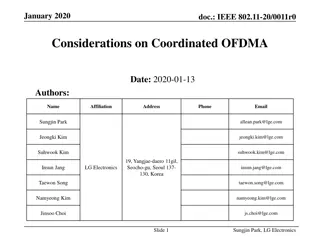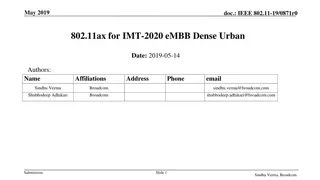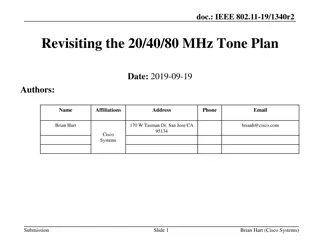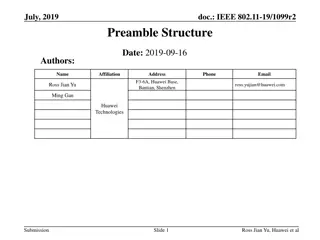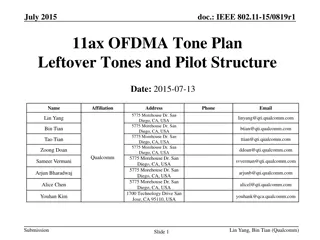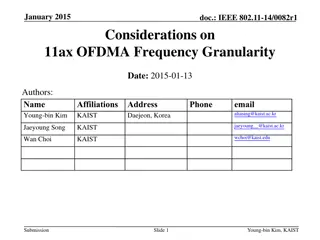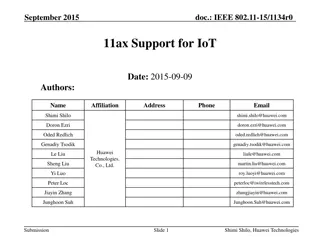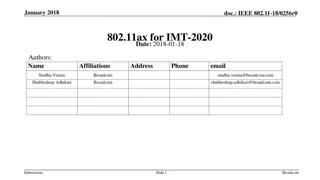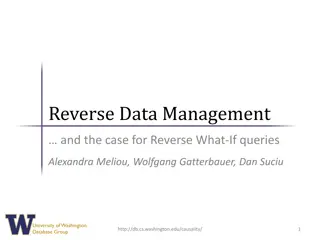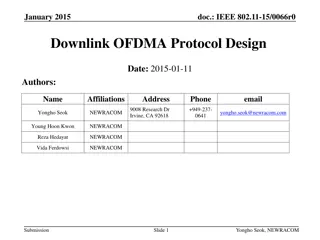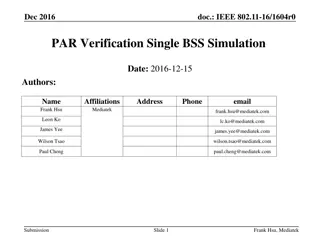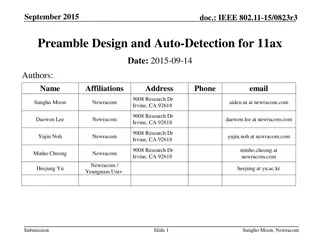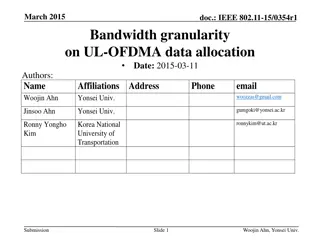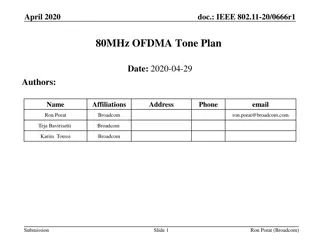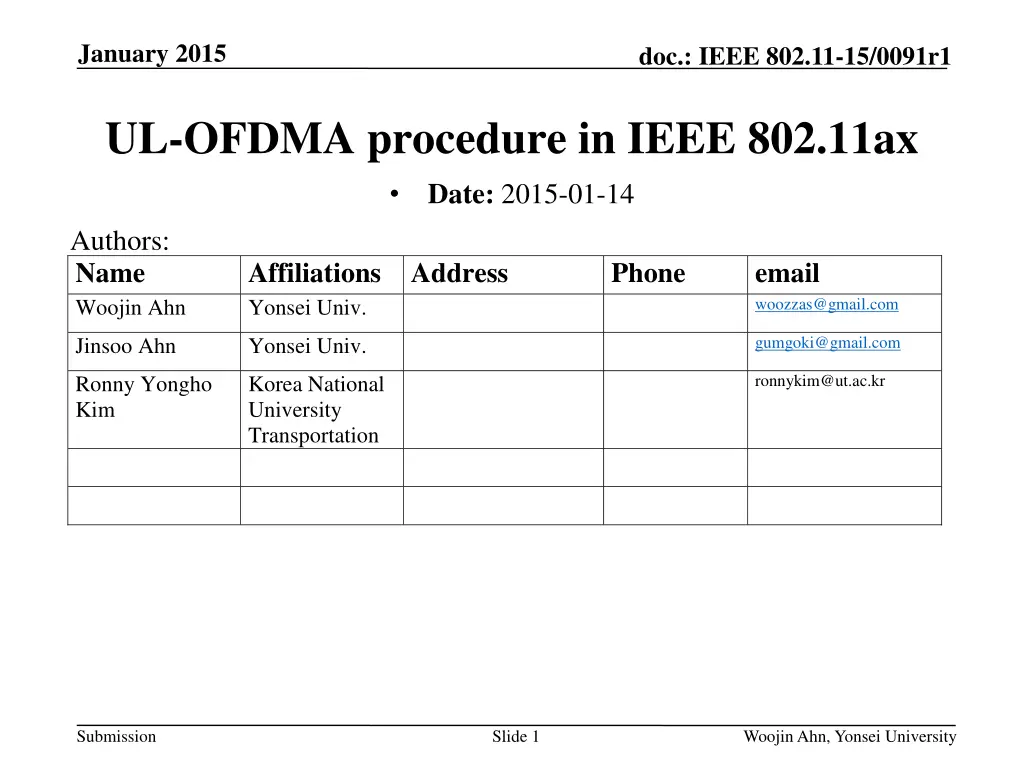
IEEE 802.11ax UL-OFDMA Procedure in January 2015
"Explore the UL-OFDMA procedure in IEEE 802.11ax discussed in January 2015, including issues, solutions, and implementation challenges for enhancing spectral efficiency and throughput. Key topics cover initiating UL-OFDMA, STA participation, scheduling, and supporting wideband operation in dense environments."
Download Presentation

Please find below an Image/Link to download the presentation.
The content on the website is provided AS IS for your information and personal use only. It may not be sold, licensed, or shared on other websites without obtaining consent from the author. If you encounter any issues during the download, it is possible that the publisher has removed the file from their server.
You are allowed to download the files provided on this website for personal or commercial use, subject to the condition that they are used lawfully. All files are the property of their respective owners.
The content on the website is provided AS IS for your information and personal use only. It may not be sold, licensed, or shared on other websites without obtaining consent from the author.
E N D
Presentation Transcript
January 2015 doc.: IEEE 802.11-15/0091r1 UL-OFDMA procedure in IEEE 802.11ax Date: 2015-01-14 Authors: Name Woojin Ahn Affiliations Address Yonsei Univ. Phone email woozzas@gmail.com gumgoki@gmail.com Jinsoo Ahn Yonsei Univ. ronnykim@ut.ac.kr Ronny Yongho Kim Korea National University Transportation Submission Slide 1 Woojin Ahn, Yonsei University
January 2015 doc.: IEEE 802.11-15/0091r1 Introduction UL-OFDMA is included in Spec Framework Document for 11ax [1],[2] UL-OFDMA is a key enabling technique to meet the requirement of throughput enhancement Number of problem statement and solutions have been discussed in TGax [3], [4], [5], [6], [7] 11ax is aiming to enhance the spectral efficiency Finer granularity of bandwidth usage (2.5/5 MHz BW) Aggressive wideband operation In this contribution, issues on UL-OFDMA procedure in 802.11ax, as well as possible solutions will be discussed With finer sub-channels, wideband operation, dense OBSS environment Submission Slide 2 Woojin Ahn, Yonsei University
January 2015 doc.: IEEE 802.11-15/0091r1 Issues on UL-OFDMA in 802.11 lack of multiple transmission control mechanism When and who to initiate UL-OFDMA? Which STA to participate or to be selected? Scheduling How to protect data transmission(NAV) from multiple groups of hidden nodes How to finish the whole procedure ACK procedure How do we support UL-OFMDA in wideband and dense OBSS environment? Submission Slide 3 Woojin Ahn, Yonsei University
January 2015 doc.: IEEE 802.11-15/0091r1 When and who to initiate UL-OFDMA Timing/power/frequency Synchronization AP can calculate the timing/power/frequency differences among STAs AP centralized initiation AP indicates each STA to adjust time/frequency/power differences[5] Trigger frame[3] Periodic or scheduling Following beacon period Whenever scheduling status meets UL-OFDMA trigger condition Depends on target situation, procedure development Submission Slide 4 Woojin Ahn, Yonsei University
January 2015 doc.: IEEE 802.11-15/0091r1 Which STA to participate AP doesn t have any information on STAs buffer status Conventional polling mechanism AP Access request Access request STA1 UL Data Request ACK Request ACK Request ACK Access request Access request Access request allocation Resource Poll collision Primary poll poll STA2 UL Data (STA1) (STA2) STA4) STA3 UL Data STAs STA4 UL Data Medium access polling Simple, stable, rich information/Large overhead UL-request frame[3] Each STA sends UL request frame independently to indicate its buffer status to AP Buffer status feedback Buffer status indication with ongoing tx/rx Reusing duplicated or reserved field of preamble/header Ex) group ID, NSTS, partial AID of UL transmission More data, more fragment bit Less overhead / limited information Slide 5 Submission Woojin Ahn, Yonsei University
January 2015 doc.: IEEE 802.11-15/0091r1 NAV Protection Each STA has different hidden nodes group In order to set NAV for every hidden nodes group, each UL-tx STA must transmit at least one RTS or CTS RTS/CTS with 802.11a format Legacy STAs cannot read Data frame STA1 Submission Slide 6 Woojin Ahn, Yonsei University
January 2015 doc.: IEEE 802.11-15/0091r1 NAV Protection STA1 Serial RTS transmission AP ACK procedures STA1 UL Data allocation Resource Scheduling Primary RTS(STA1) RTS(STA2) RTS(STA3) RTS(STA4) CTS STA2 UL Data STA3 UL Data STAs STA4 UL Data NAV NAV reset! Large overhead CTS time out Reset NAV if no PHY-RXSTART.indication with a duration of (2 aSIFSTime) + (CTS_Time) + aPHY-RX-START-Delay + (2 aSlotTime) The hidden nodes group of STA1 won't receive any RXstart. indication within the time limit First RXSTART.indicator CTS Timeout Submission Slide 7 Woojin Ahn, Yonsei University
January 2015 doc.: IEEE 802.11-15/0091r1 NAV setting using common CTS CTS-to-STA group CTS-to-STA group AP RA ACK STA1 UL Data allocation allocation Resource Resource Common CTS Common CTS Scheduling Primary RA ACK STA2 UL Data RA ACK STA3 UL Data RA ACK or STAs STA4 UL Data CTS-to-STA group Using CTS to prevent hidden nodes group from resetting NAV CTS doesn t have condition for resetting NAV Assign a dedicated multicast address for 11ax UL-OFDMA Common CTS[3] Every UL-OFDMA participants send CTS with identical waveform E.g., DA: AP, SA: multicast address for 11ax UL-OFDMA Resource allocation acknowledgement might follow Submission Slide 8 Woojin Ahn, Yonsei University
January 2015 doc.: IEEE 802.11-15/0091r1 ACK procedure AP sACK AP STA1 UL Data STA1 UL Data ACK(STA1) ACK(STA1) ACK(STA2) ACK(STA3) ACK(STA4) sACK Primary Primary STA2 UL Data STA2 UL Data sACK STA3 UL Data STA3 UL Data sACK STAs STA4 UL Data STAs STA4 UL Data DIFS ACK duration EIFS Serial ACK transmission Large overhead Sub-channel based ACK Less overhead Unfairness between Legacy and ax STAs STA that received erroneous frame previously has to defer EIFS The STA having the shorter EIFS parameter has the higher channel access probability[8] Submission Slide 9 Woojin Ahn, Yonsei University
January 2015 doc.: IEEE 802.11-15/0091r1 ACK procedure using common ACK AP sACK STA1 UL Data Common ACK sACK Primary STA2 UL Data sACK STA3 UL Data sACK STAs STA4 UL Data AP & STAs Sub-channel based ACK Acknowledgement of received data Common ACK Preventing legacy STAs from waiting for EIFS Identical waveform Submission Slide 10 Woojin Ahn, Yonsei University
January 2015 doc.: IEEE 802.11-15/0091r1 UL-OFDMA in wideband operation In dense OBSS environment STAs might belong to different OBSSs Primary Secondary1 Secondary2 Secondary3 Secondary4 Secondary5 Secondary6 Secondary7 AP initiates UL-OFDMA after CCA The snapshot of CCA results could be different from each other Channel availability Which band should be assigned to which STAs? Submission Slide 11 Woojin Ahn, Yonsei University
January 2015 doc.: IEEE 802.11-15/0091r1 UL-OFDMA in wideband operation CTS-to-STA group AP CCA feedback allocation Resource CCA feedback CCA feedback CCA feedback CCA feedback Scheduling request Primary (STA1) (STA2) (STA3) (STA4) AP STA1 STA2 STA3 STA4 STAs CTS-to-STA group AP CTS-to-STA group AP Duplicated CTS allocation Resource CCA feedback Scheduling STA1 UL Data Secondary 1 Primary allocation Resource CCA feedback CCA feedback request (STA1) (STA2) STA2 UL Data STAs STAs CTS-to-STA group CTS-to-STA group AP AP CCA feedback Secondary 2 Secondary 1 allocation Duplicated CTS Resource allocation Resource request STA3 UL Data STA4 UL Data STAs STAs CTS-to-STA group AP STA1, STA2 -> primary STA3, STA4 -> secondary 1 CCA feedback Secondary 3 allocation Resource CCA feedback CCA feedback request (STA1) (STA3) STAs STAs should inform AP of both their buffer status and channel availability Channel availability feedback might also introduce massive overhead Submission Slide 12 Woojin Ahn, Yonsei University
January 2015 doc.: IEEE 802.11-15/0091r1 Code based access Pseudo random code Enhancing CSMA/CA performance via introducing code based contention mechanism[9], [10] PRACH, PUCCH, PUSCH in LTE CAZAC sequence (Zadoff-chu) Code access could play a role both for channel availability feedback and buffer status indication Every 11ax STA that has uplink data simultaneously sends a chosen code to clear-assessed channels after CTS-to-STA group AP CTS-to-STA group Code assignment Randomly chosen from code set Unique code for each STA allocation Resource Primary 4 3 2 1 STAs Submission Slide 13 Woojin Ahn, Yonsei University
January 2015 doc.: IEEE 802.11-15/0091r1 Comparison of channel availability feedback AP STA1 STA2 STA3 STA4 CTS-to-STA group CTS-to-STA group AP CCA feedback allocation allocation Resource Resource CCA feedback CCA feedback CCA feedback CCA feedback Scheduling request Primary (STA1) (STA2) (STA3) (STA4) 4 3 2 1 STAs CTS-to-STA group CTS-to-STA group AP CCA feedback Secondary 1 allocation allocation Resource Resource CCA feedback CCA feedback request (STA1) (STA2) 2 1 STAs CTS-to-STA group CTS-to-STA group AP CCA feedback Secondary 2 allocation Resource request STAs CTS-to-STA group CTS-to-STA group AP CCA feedback Secondary 3 allocation allocation Resource Resource CCA feedback CCA feedback request (STA1) (STA3) 3 1 STAs Conventional round robin Code based Submission Slide 14 Woojin Ahn, Yonsei University
January 2015 doc.: IEEE 802.11-15/0091r1 Expected form of UL-OFDMA procedure CTS-to-STA group AP sACK Access code 8 7 6 5 4 3 2 1 Common ACK allocation Resource Common CTS STA4 UL Data sACK Primary sACK STA1 STA5 UL Data sACK STAs STA2 CTS-to-STA group AP sACK Secondary 1 STA3 Common ACK allocation Resource Common CTS STA3 UL Data sACK 7 5 3 2 1 sACK STA4 STA7 UL Data sACK STAs STA5 CTS-to-STA group AP sACK STA6 Secondary 2 Common ACK allocation Resource Common CTS STA1 UL Data sACK 8 7 6 2 1 STA7 sACK STA8 UL Data sACK STA8 STAs CTS-to-STA group AP sACK Secondary 3 Common ACK allocation Resource Common CTS STA2 UL Data sACK sACK 6 2 1 STA6 UL Data sACK STAs Submission Slide 15 Woojin Ahn, Yonsei University
January 2015 doc.: IEEE 802.11-15/0091r1 Conclusion In this contribution, we discussed issues on UL-OFDMA procedure in 802.11ax, as well as possible solutions UL-OFDMA might cause massive control overhead, and unstable transmission protection Due to lack of multiple transmission control mechanism Developments or modifications on Scheduling, NAV setting, ACK procedure, channel availability feedback are necessary We introduced several possible solutions to the discussed issues Common CTS/ACK(identical wave form) transmission NAV setting, ACK procedure Code based access Scheduling, CCA feedback Submission Slide 16 Woojin Ahn, Yonsei University
January 2015 doc.: IEEE 802.11-15/0091r1 Reference [1][14/1453/r2] Spec Framework Proposal [2][14/1447/r1] Proposed Spec Framework Document for 11ax considering po tential tech features [3][14/1431/r1] Issues on UL-OFDMA [4][14/1446/r0] Analysis of frequency and power requirements for UL- OFDMA [5][14/0802/r0] Consideration on UL MU transmission [6][14/1190/r2] Frame Exchange Control for Uplink Multi-user transmission [7][14/1232/r1] On Multi-STA Aggregation Mechanism in 11ax [8][14/1211/r0] Ack Procedure for OFDMA [9][14/0616/r0] CSMA/CA enhancements [10][14/1681/r1] 802.11 Tgax PHY Frame Structure Discussion for Enabling New Contention Mechanism Submission Slide 17 Woojin Ahn, Yonsei University
January 2015 doc.: IEEE 802.11-15/0091r1 Straw Poll 1 Do you agree to add to the TG Specification Framework: x.y.z AP shall indicate UL OFDMA initiation. Y N ABS Submission Slide 18 Woojin Ahn, Yonsei University
January 2015 doc.: IEEE 802.11-15/0091r1 Straw Poll 2 Do you agree to add to the TG Specification Framework: x.y.z UL OFDMA uplink channels shall be allocated con sidering STAs channel status. Y N ABS Submission Slide 19 Woojin Ahn, Yonsei University
January 2015 doc.: IEEE 802.11-15/0091r1 Straw Poll 3 Do you agree to add to the TG Specification Framework: x.y.z UL OFDMA shall provide NAV setting mechanism for allocated channels. Y N ABS Submission Slide 20 Woojin Ahn, Yonsei University

